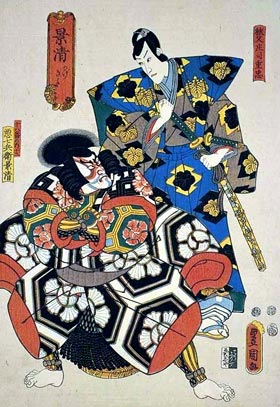| KAGEKIYO |
| Play titles | Kagekiyo ďich˘ Sakae Kagekiyo |
Author | Murase Genzabur˘ (1732 "ďich˘ Sakae Kagekiyo") | ||||||||||||||||||||||||||||||||||
| History |
The drama "Kagekiyo" was staged for the first time in the 9th lunar month of 1732 at the Nakamuraza, under the title "drama "ďich˘ Sakae Kagekiyo" [casting]. This is the official premiere of "Kagekiyo" from a Kabuki Jűhachiban perspective but it has to be said that a similar play was staged earlier, in the 11th lunar month of 1706 at the Yamamuraza but the leading actor in the role of the warrior Kagekiyo was not an actor from the Ichikawa clan and, therefore, this early version was not taken into account [casting]. This role became a great one for the Ichikawa Danjűr˘ line of actors, was revived several times by different actors and was integrated in the Kabuki Jűhachiban collection of plays of the Ichikawa clan by Ichikawa Ebiz˘ V in 1840:
It fell into oblivion for a while and was revived at the beginning of the twentieth century several times in koshibai theaters, like the Asakusaza (October 1902) or the Kotobukiza (october 1904). The first revival in a ˘shibai theater happened in November 1908 at the Kabukiza [casting]. This version had a Tokiwazu musical accompaniment. The first 20th century revival with a ďzatsuma ensemble was produced at the National Theatre in August 1973, starring Ichikawa Ebiz˘ X in the role of Akushichiby˘e Kagekiyo. A newly-created drama, which was entitled "Kotohoide Mimasu Kagekiyo", was staged in January 2014 at the Shinbashi Enbuj˘ and starred Ichikawa Ebiz˘ XI in the role of the warrior Akushichiby˘e Kagekiyo. This drama was created by mixing scenes and elements coming from 4 kagekiyomono belonging to the Kabuki Jűhachiban: "Kan U", "Kagekiyo" "Kamahige" and "Gedatsu" [more details]. This drama was also staged in September 2014 at the Minamiza. |
||||||||||||||||||||||||||||||||||||
| Key words |
Akushichiby˘e Kagekiyo Aragoto Genji Heike Kagekiyomono Kabuki Jűhachiban ďzatsuma Taira Kagekiyo |
||||||||||||||||||||||||||||||||||||
| Summary |
Certainly very little of the world of reality clings about the material or movement of this one-act species of drama which has for motive the valour and strength of Kagekiyo, a general of the Heike clan, whose cause has been defeated and who is confined in a cavern. His appearance is dramatic in the extreme, when the guards allow him to gaze forth from a square opening in the bars of his prison-cave. His face is heavily lined with broad red lines, his fierce and threatening top-knot of hair that stands straight on end is accentuated by peculiar side wings of lacquered wood suggesting strands of hair that form a frame for the ferocious countenance. His costume of glittering gold brocade, with vivid touches of green and red, is in keeping with the strange visage of the dauntless warrior. That he may taste all the bitterness of defeat, his wife and daughter are led in bound with rope, and he is brought forth to speak with them, his arms tied behind him in the most approved manner of the modern serial moving picture. When everything seems against the outlandish hero, he is freed from his fetters and allowed to sit on a huge boulder in the centre of the stage, where he postures as he relates the misfortunes of his clan and declares his loyalty--an active figure whose every gesture is all the more conspicuous because of the groupings of the immovable personages on either side. Kagekiyo shows some traces of human emotion, and is overcome at the treatment meted out to his wife and daughter, yet still keeps a stout heart, even when his son is placed within the gloomy cavern. He scorns the Genji generals who gaze on his captivity, by refusing their offerings of food, kicking it unceremoniously away, and bellows in the extravagant style that is so typical of aragoto. At length his outraged feeling getting the best of him he lifts up the great stone on which he has been sitting and uses it as a missile to throw at the Genji followers, who, driven hither and thither, are finally routed. Kagekiyo, fighting to a finish, reaches a climax of grotesqueness as he poses in triumphant attitude brandishing a large beam of wood which has been his weapon of defence. ZoŰ Kincaid in "Kabuki, the Popular Stage of Japan" |
 |
|
The actors Ichikawa Ebiz˘ V (left) and his son Ichikawa Danjűr˘ VIII (right) playing the roles of Akushichiby˘e Kagekiyo and Shigetada in the drama "Kagekiyo" (print made in 1852 by Utagawa Toyokuni III) |
|
|
| Contact | Main | Top | Updates | Actors | Plays | Playwrights | Programs | Links | FAQ | Glossary | Chronology | Illustrations | Prints | Characters | Derivatives | Theaters | Coming soon | News |